The Disgraceful Context of Morimiya Middle School Shooting
Joey Wawzonek

Content Warning: Murder, gun violence, child death, sexual violence, cannibalism, suicide, gore, eroticism of gore, knife violence, glorification of tragedy and crime, misogyny, racism, Islamophobia. This article was originally published on November 1, 2022, then republished on February 10, 2024. Previous numbers have been struck-through, with updated figures beside them.
Preface
Morimiya Middle School Shooting is a heinous work. On a surface level it is reprehensible. Digging into it makes every aspect of it worse. This is a creation that exists within an ecosystem of glorification, a digital artifact with a dedicated following - and understanding both reveals uncomfortable truths about certain corners of gaming culture and how tragedy becomes commodified entertainment.
The United States has had 27 30 32 school massacres (defined as at least four murdered victims) since 1927. 16 19 21 of these occurred after Columbine. All but two were carried out with the use of firearms. Since 2000, there have been 388 519 584 school shootings in the United States.
Canada has had three school massacres ever (ignoring the genocide perpetrated by the Residential School system). One of these occurred after Columbine. It was carried out with a firearm. Since 2000, there have been 8 11 school shootings in Canada.
Japan has had one school massacre ever. It occurred on June 8, 2001. Eight children were murdered. All but one were girls. The perpetrator used a kitchen knife. There has never been a school shooting in Japan. There have been three four multiple fatality shootings in Japan since 1952.
 Osaka Kyoiku University Ikeda Elementary School
Osaka Kyoiku University Ikeda Elementary School
Potential: Morimiya as Art
I think this is important to bring up because, from a Western and particularly an American perspective, school shootings are a dark reality that happens with shocking yet numbing frequency. The Onion's perennial publishing of their "No Way to Prevent This" article is testament to that. While it would be disingenuous to say school shootings have had no resonance in Japan, they simply have not happened there. This distance from tragedy lessens its emotional impact.
Within this context, Morimiya Middle School Shooting (MMSS) reads as initially intensely insensitive but not outright malicious -- akin to Postal or Hatred, mimicking real world tragedy without specific reference to any event. One could argue it offers commentary on why school shootings happen. The unnamed player character walked in on her mother's suicide, her father was an abusive alcoholic who disappeared. Her rage turns outward towards those who do not give her the attention she was missing from her parents. It ultimately manifests as a desire to commit murder after the game's fictionalised news media reports on regional mass killings.
Like Super Columbine Massacre RPG, MMSS positions itself as a work demanding societal introspection alongside our horror. By avoiding reference to specific historical events, MMSS could theoretically comment on tragedy more broadly without directly reopening wounds. Its nameless protagonist and gamification of school shootings might implicate players in the violence -- similar to Brenda Romero's 2009 board game Train wherein players unknowingly transport prisoners to concentration camps before realising their complicity at the game's conclusion.
Even its arcade gameplay loop, high scores, and unlocks could serve a purpose. During my playthroughs I kept hoping for some final message, some revelation that would justify this glorification of violence. That the thoughtful player might expect MMSS to build toward a moment of self-disgust or societal critique -- a payoff that transforms the experience into meaningful commentary. Yet, as my investigation revealed, MMSS shares more in common with JFK: Reloaded than with works of genuine artistic provocation; the game's design, context, and surrounding ecosystem suggest more troubling purposes than mere transgressive art. It teaches nothing. It says nothing. It exists merely to shock and hurt.
Play: Morimiya's Mechanics
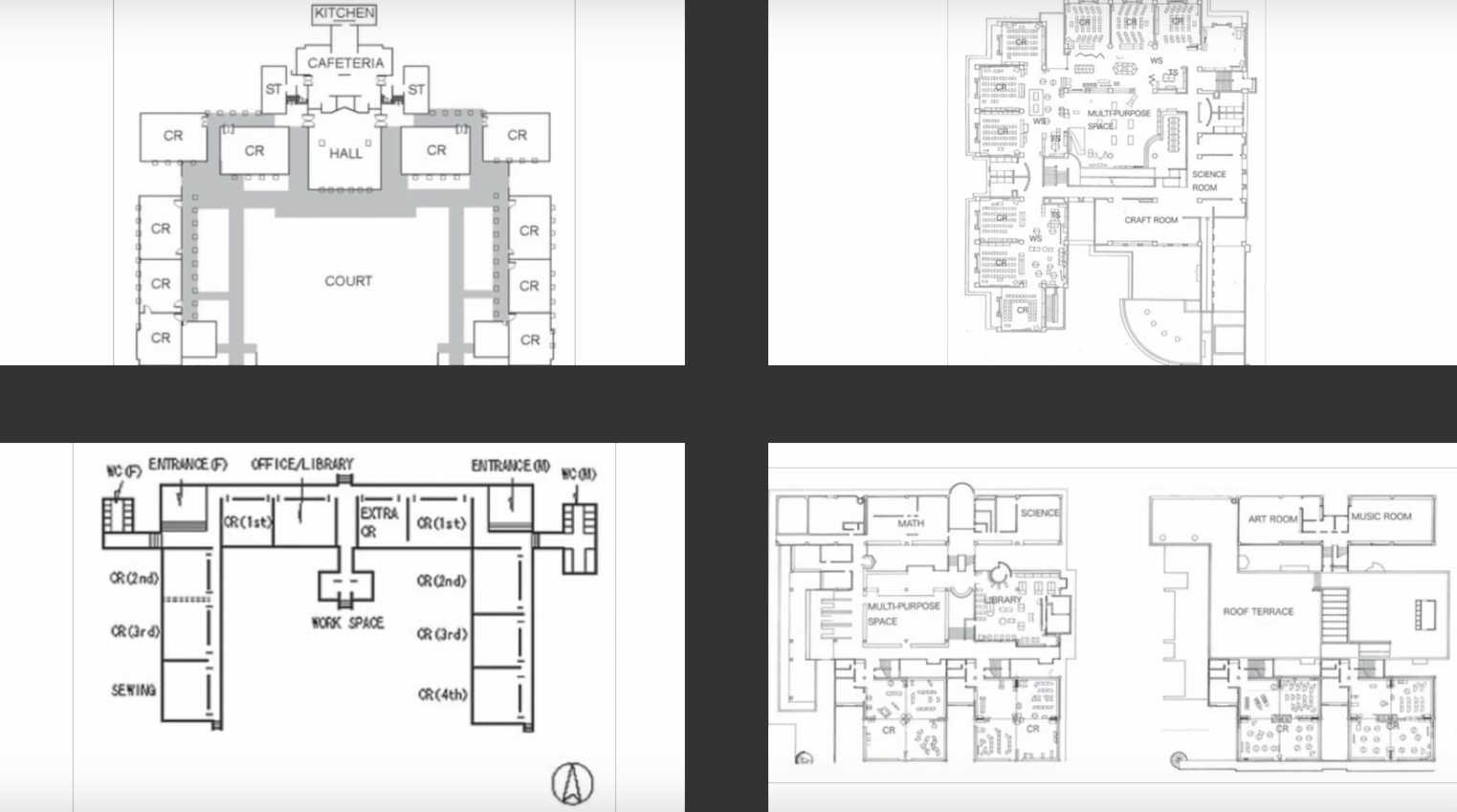
MMSS achieves a perverse technical accomplishment: it transforms RPGMaker -- intended for traditional turn based JRPGs -- into a competent arcade shooter with strategic depth. The developer has meticulously considered how the archictecture of a typical Japanese school would serve the mechanics of mass violence. Student flee in predictable patterns through familiar hallways. The player must manage ammunition across weapons, slow their movement to maintain accuracy, and work against a timer simulating police response. Most disturbing is the scoring system, which awards more points for murdering female students -- a detail that reveals the creator's influence and misogynistic intent.
The game's mechanics force a sickening recognition: school shooters don't simply point and shoot. They plan. They strategise. They adapt. This understanding is embedded into every aspect of MMSS' design. None of this is particularly fun, even divorced from its horrific subject matter, but it achieves a baseline of engagement that keeps players involved just enough to warrant multiple playthroughs. The technical achievement only makes the ethical failure more pronounced.
What MMSS does mechanically should be recognised as deliberately crafted rather than accidentally competent. The way it transcends RPGMaker's limitations demonstrates intentionality behind every design choice. The scoring system especially -- with its gender-based point values -- cannot be dismissed as arbitrary. It exists as a direct extension of the creator's worldview, one that specifically targets and objectifies female victims.
Precedent: Before Morimiya
Any discussion of MMSS demands we confront its creator and their artistic milieu. The solo developer -- known variously as エリック, erikku, eric806359, and kata235 -- is an ero guro artist, though this classification requires immediate quilification. Unlike H.R. Giger, whose biomechanical grotesqueries maintain artistic distance from their disturbing subject matter, erikku's work aligns more with the Marquis de Sade's gleeful depravity. Scrolling through erikku's Twitter feed and Pixiv portfolio feels like an archaeological excavation of moral decay -- each post and image revealing deeper layers of deliberate transgression.

For erikku, ero guro is not some cathartic 'release valve' or artistic experiment; it represents the totality of their creative output and apparent worldview. The obsession with the macabre appears less as artistic expression and more as personal manifesto. This context isn't incidental to understanding MMSS -- it is essential.
Perusal: Supplementing Morimiya
MMSS itself contains no explicit sexual content -- a curious omission that might suggest the game stands apart from erikku's ero guro oeuvre. This technical absence of eroticism functions as deliberate misdirection. The game exists within an ecosystem of the creator's sypplementary materials that transform the player's experience through contextual knowledge. When erikku illustrates MMSS' protagonist, she appears alongside disemboweled nude women, strangled schoolgirls, and cannibalised corpses. The connection is unmistakable.
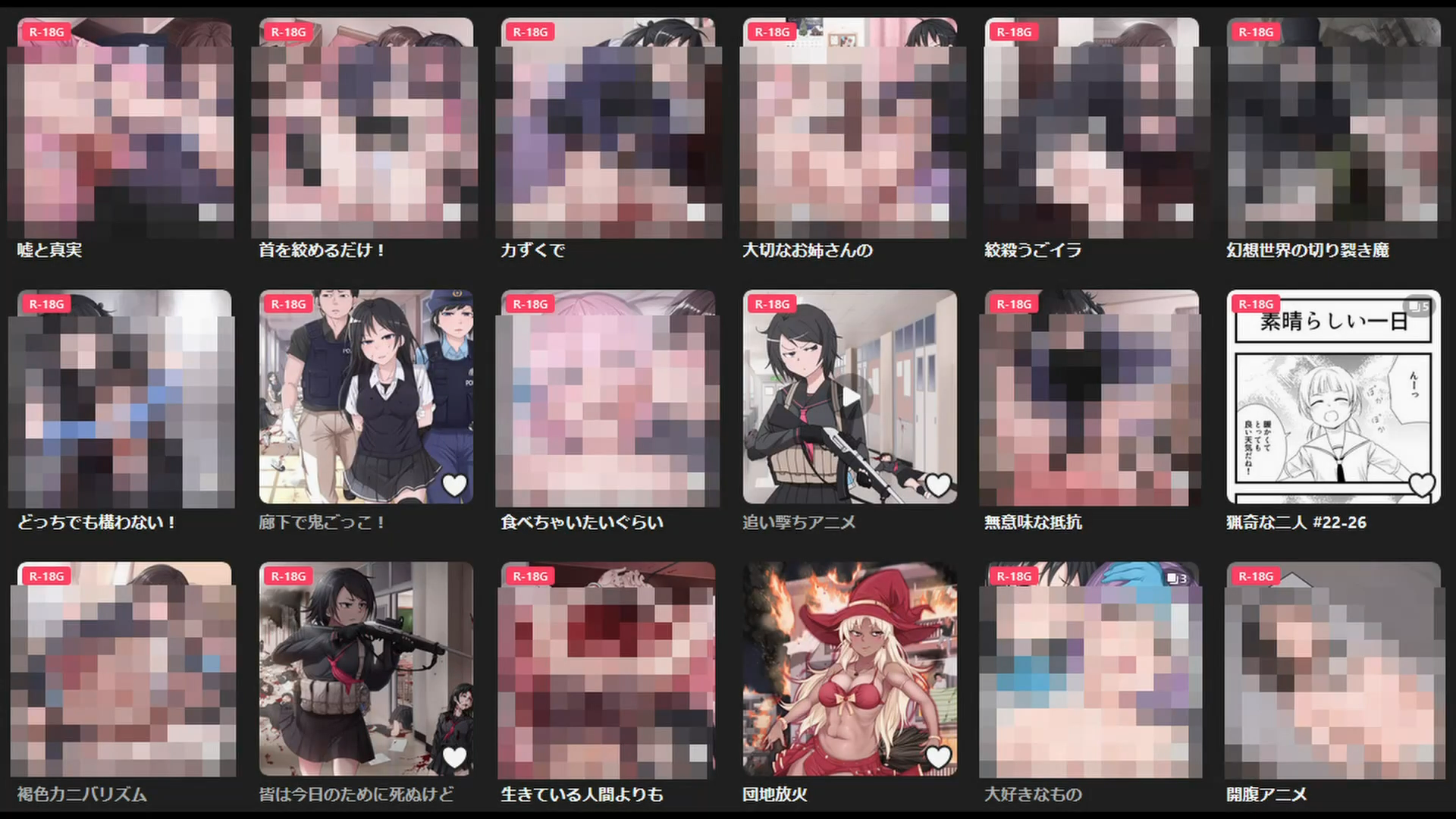

What RPGMaker cannot render in high fidelity, erikku provides through external animations: schoolgirls with exaggreated physiques being gunned down, their deaths fetishised through sexualised presentation. These aren't mere bonus content; they're completion of the intended experience. For erikku's audience -- certainly not casual players like you or I -- these supplementary materials don't merely enhance the game; they reveal its true purpose.
My research into these materials has permanently altered my perception of MMSS. What once appeared as rudimentary pixel violence now carries the shadow of erikku's detailed illustrations. What's particularly telling is how MMSS' animations are bundled with erikku's other ero guro works, creating a continuum between game and explicit sexual content. The mind makes these connection inevitably. In the intended consumptive pattern, MMSS is not a standalone game, but rather one component in an integrated experience of sexualised violence.
Pang: Morimiya and Real Tragedy
MMSS', news segment contains a moment of unmistakable historical reference: a middle-school girl in police custody while her victims clutch their bleeding abdomens. The weapon used: a kitchen knife. The targets: primarily female students.
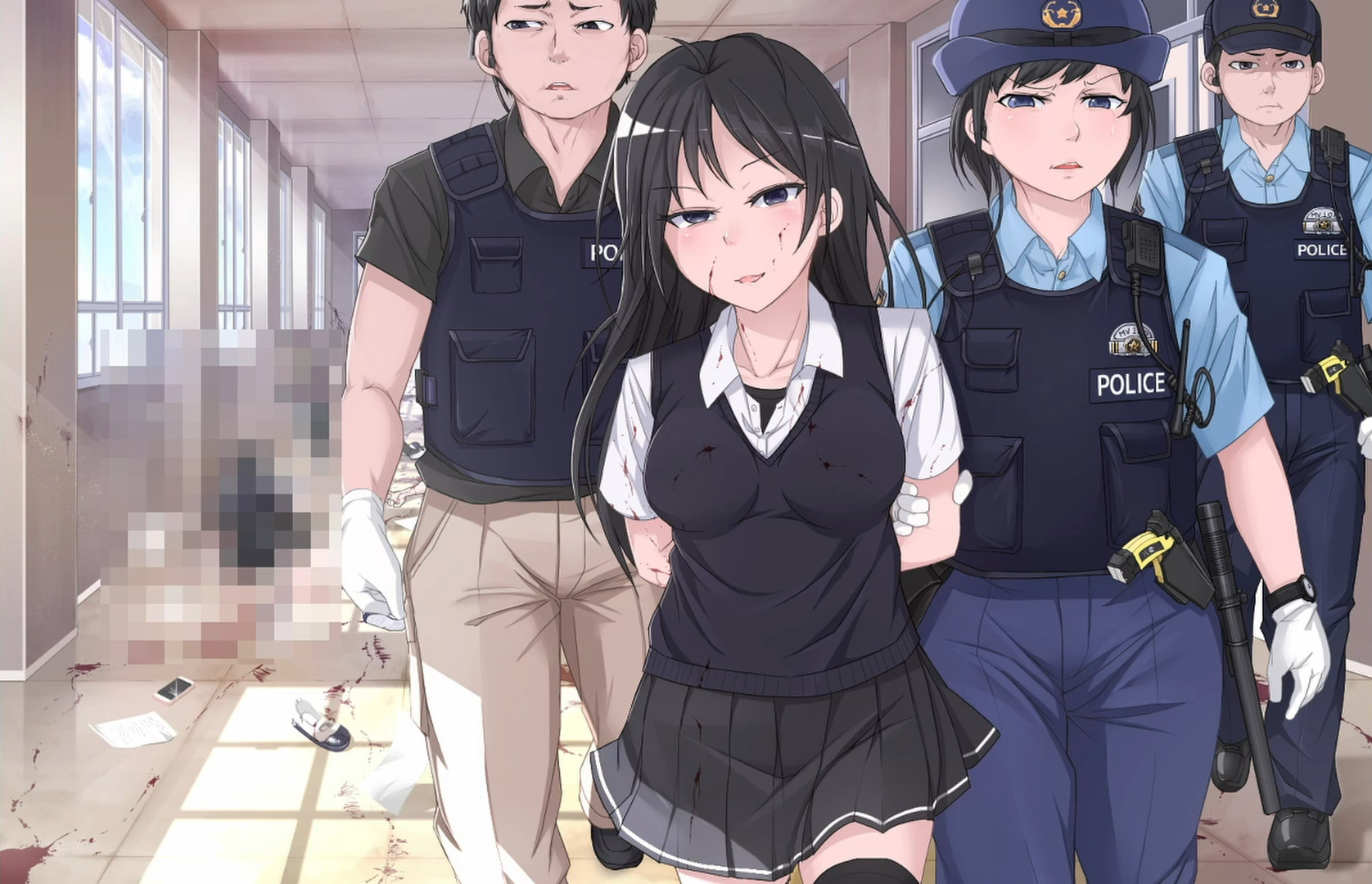
As noted earlier, Japan has experienced exactly one school massacre in its modern history -- the 2001 Osaka Kyoiku University Ikeda Elementary School tragedy. Eight children were killed, seven of them girls. The perpetrator used a kitchen knife.
The reference transcend mere tastelessness; it deliberately invokes a specifical national trauma. What's more, erikku's dedicated audience would immediately recognise this as a callback to his earlier game, Rouka de Onigokku (Tag in the Hallway), where players sprint through school corridors stabbing students to the incongruously jaunty William Tell Overture. The connection isn't subtle -- MMSS even allows players to unlock a kitchen knife weapon, explicitly linking these two works and their shared fixation on the Osaka school massacre.
While MMSS might claim plausible deniability through its broader approach to school violence, Rouka de Onigokku abandons all pretense. Together, they form a disturbing diptych -- one referencing tragedy broadly, the other precisely. The designer's fascination with this specific act of violence against children reveals a premeditated callousness that defies comprehension. And yet, as my investigation continued, I discovered this was merely the surface of erikku's depravity.
Perturbed: The Ethos of Morimiya
Documentation of MMSS on the English-speaking clearnet is surprisingly sparse -- a digital artefact that exists primarily through whispered references and broken links. My own discovery came through chance. What began as academic curiosity quickly descened into a disturbing rabbit hole.
After MMSS' release, erikku maintained an active presence on Twitter and peing -- a Japanese Q&A platform -- responding to fans in Japanese and occasionally English. These interactions reveal something crucial: MMSS and Rouka de Onigokku aren't merely abstract studies of disturbed psychology or provocative artistic statements. They represent deliberate, calculated output of an individual who revels in the intersection of violence and sexual gratification.
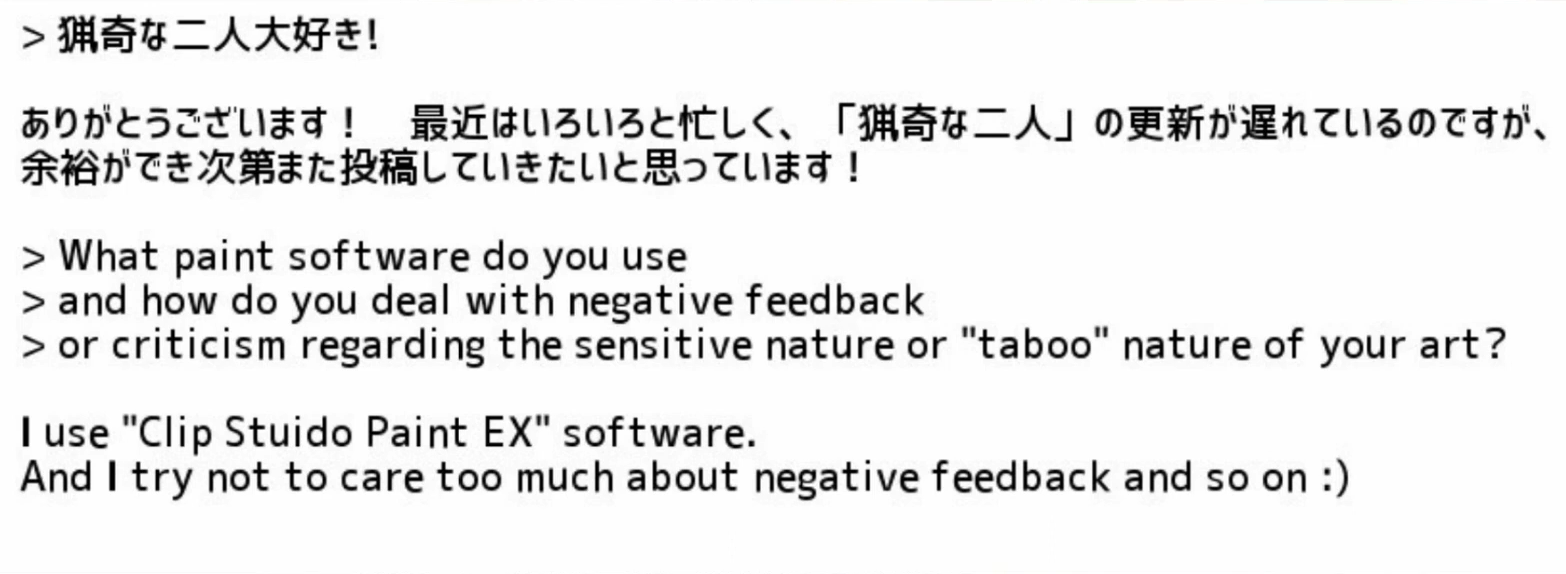
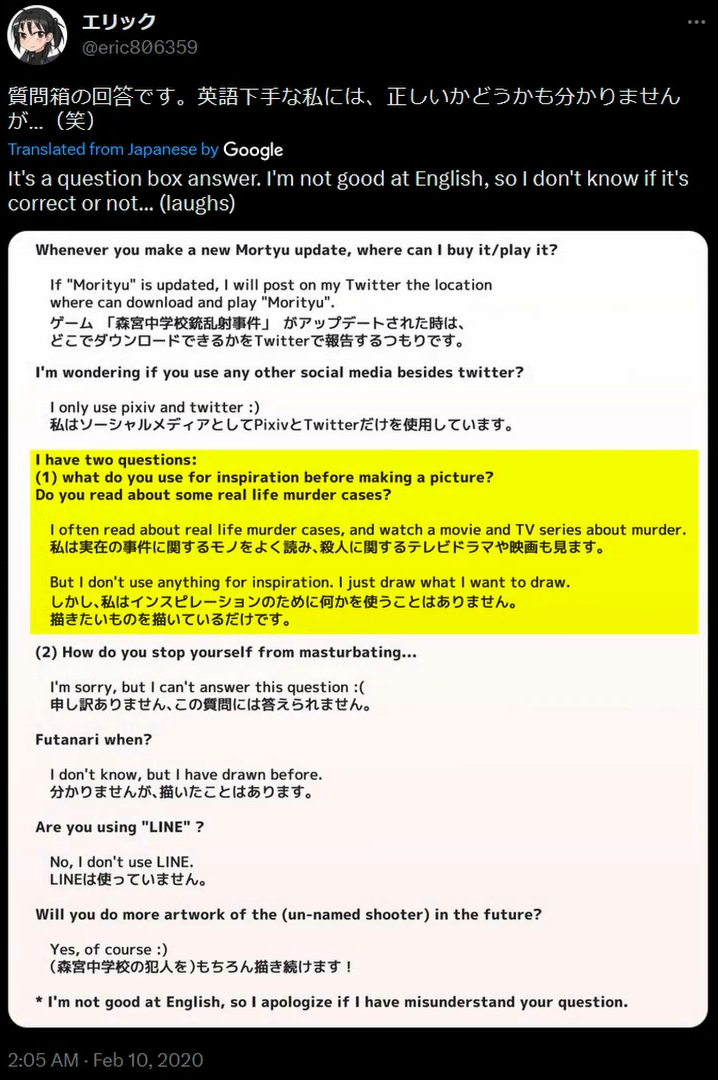
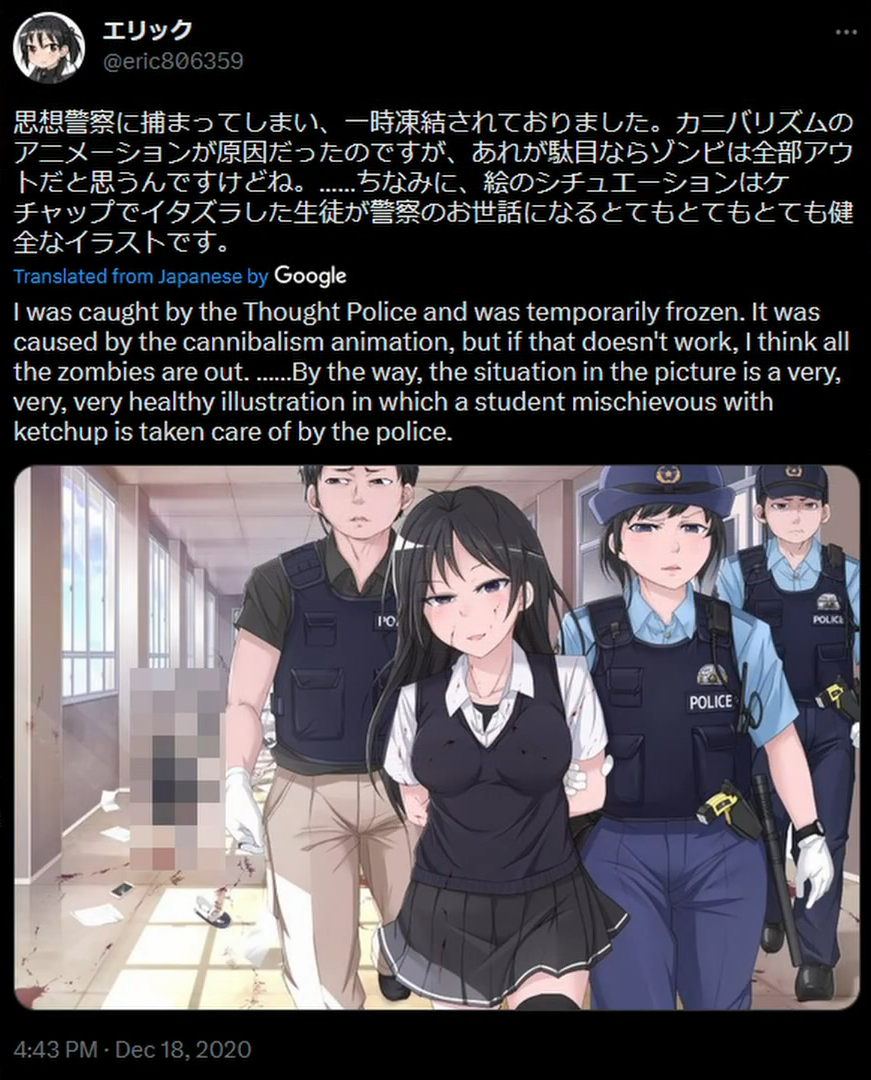
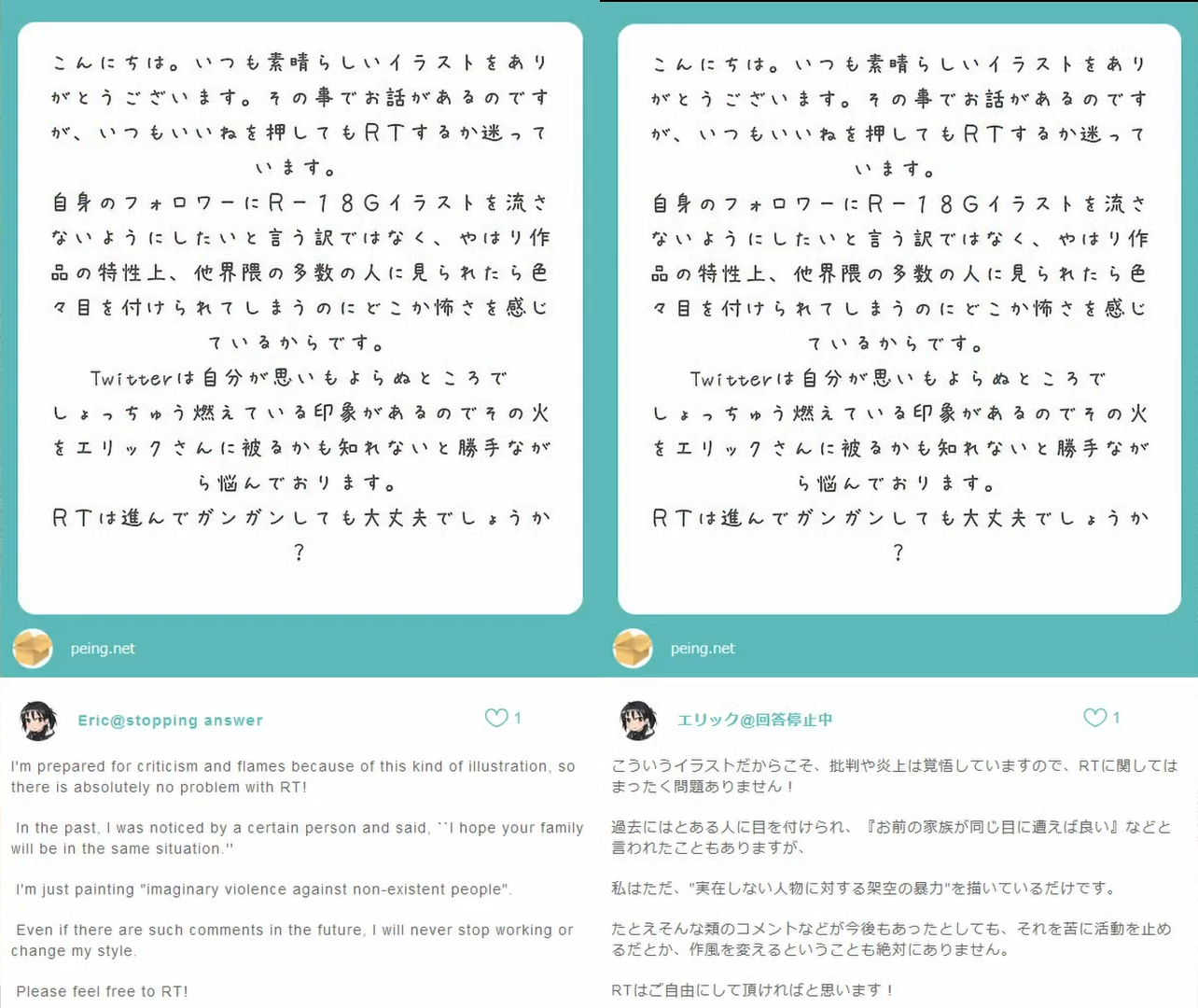
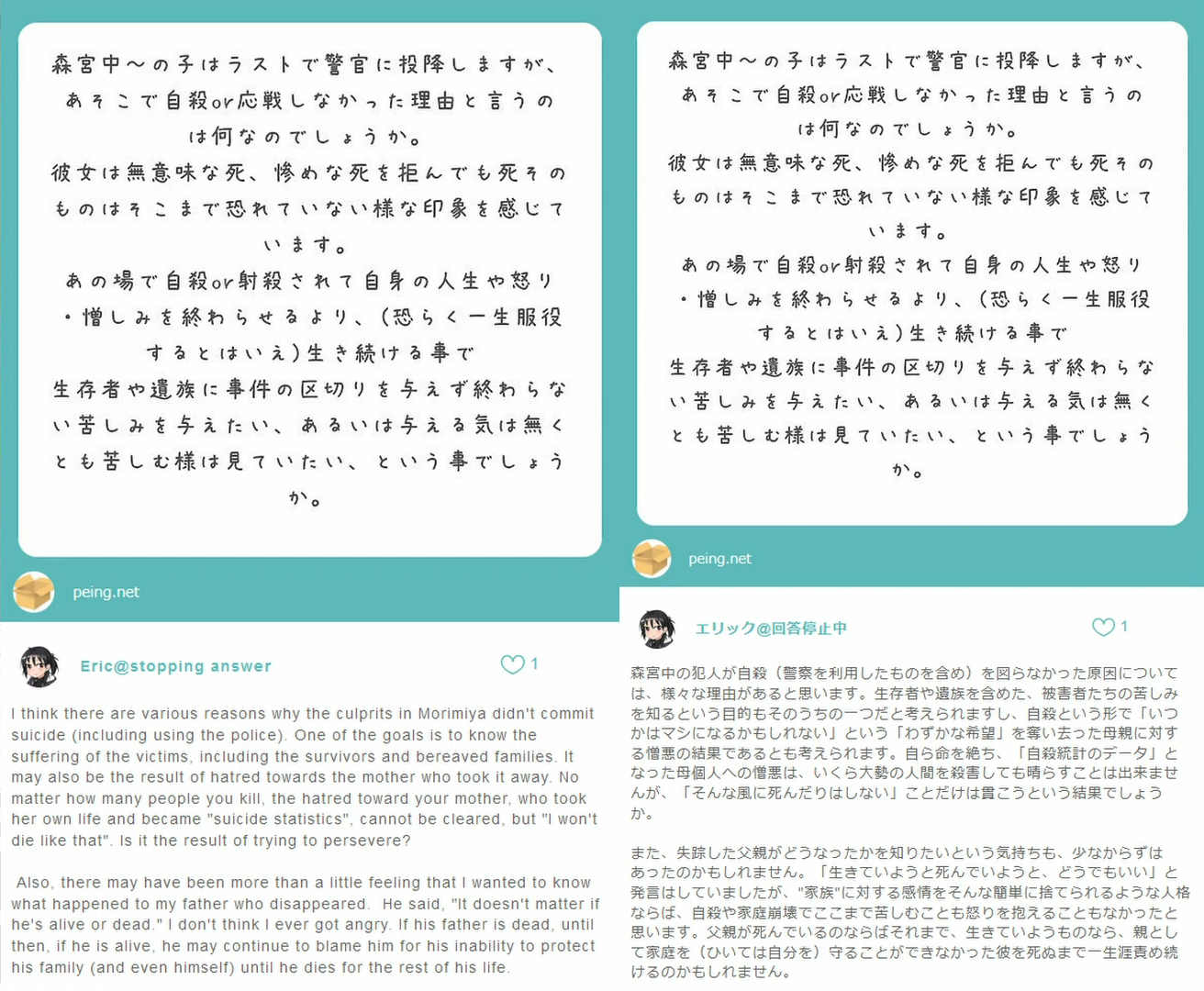
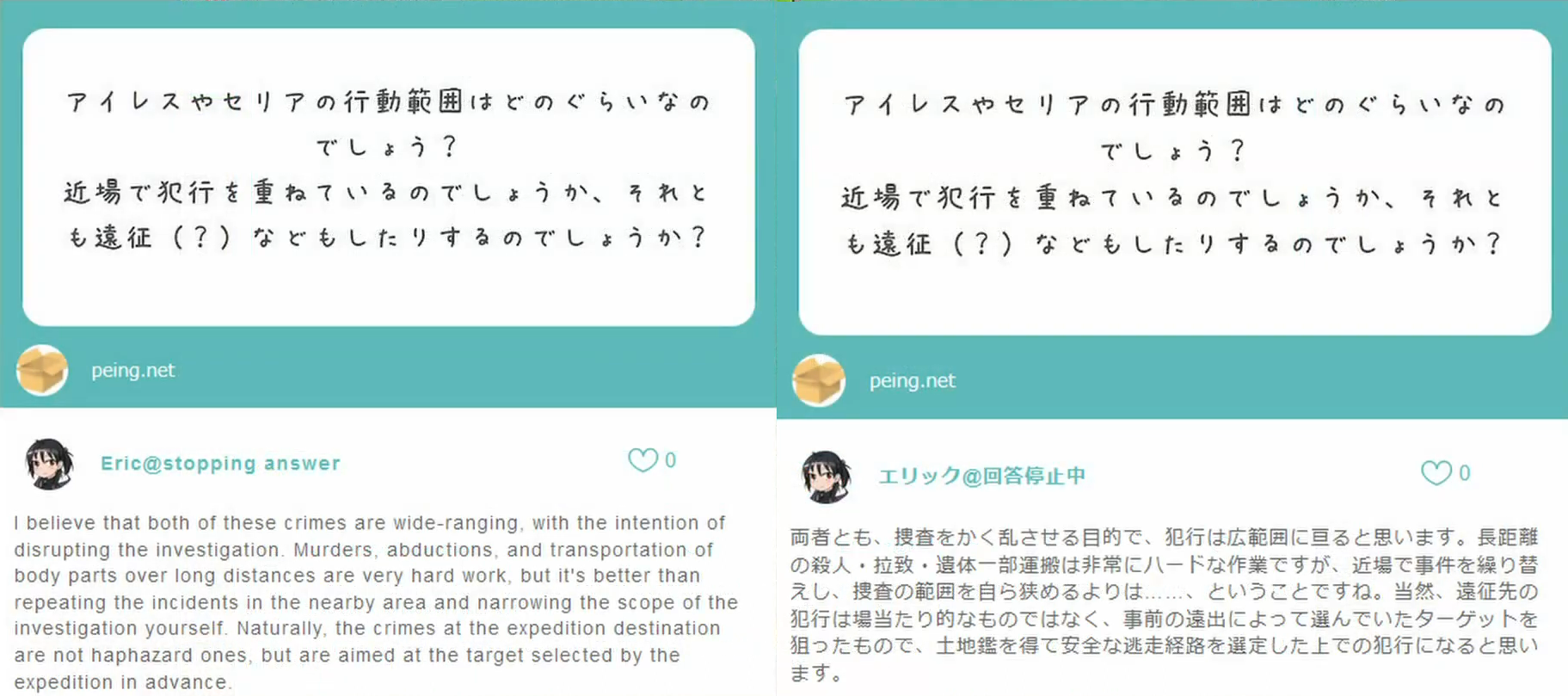

The games themselves are merely the public-facing elements of erikku's broader project. His interactions with fans demonstrate not embarrassment or artistic justification, but pride. This wasn't the end of my findings, however -- the ecosystem surrounding these games proved even more disturbing than the products themselves.
Perverse: Beyond Morimiya
My search for information about MMSS yielded surprisingly few results, with the RPGMaker Fandom wiki serving as one of the only accessible documentation points. It was here I obtained the Google Drive link to download the game, but more significantly, discovered a link to the 'Official Discord,' operating with erikku's explicit approval.
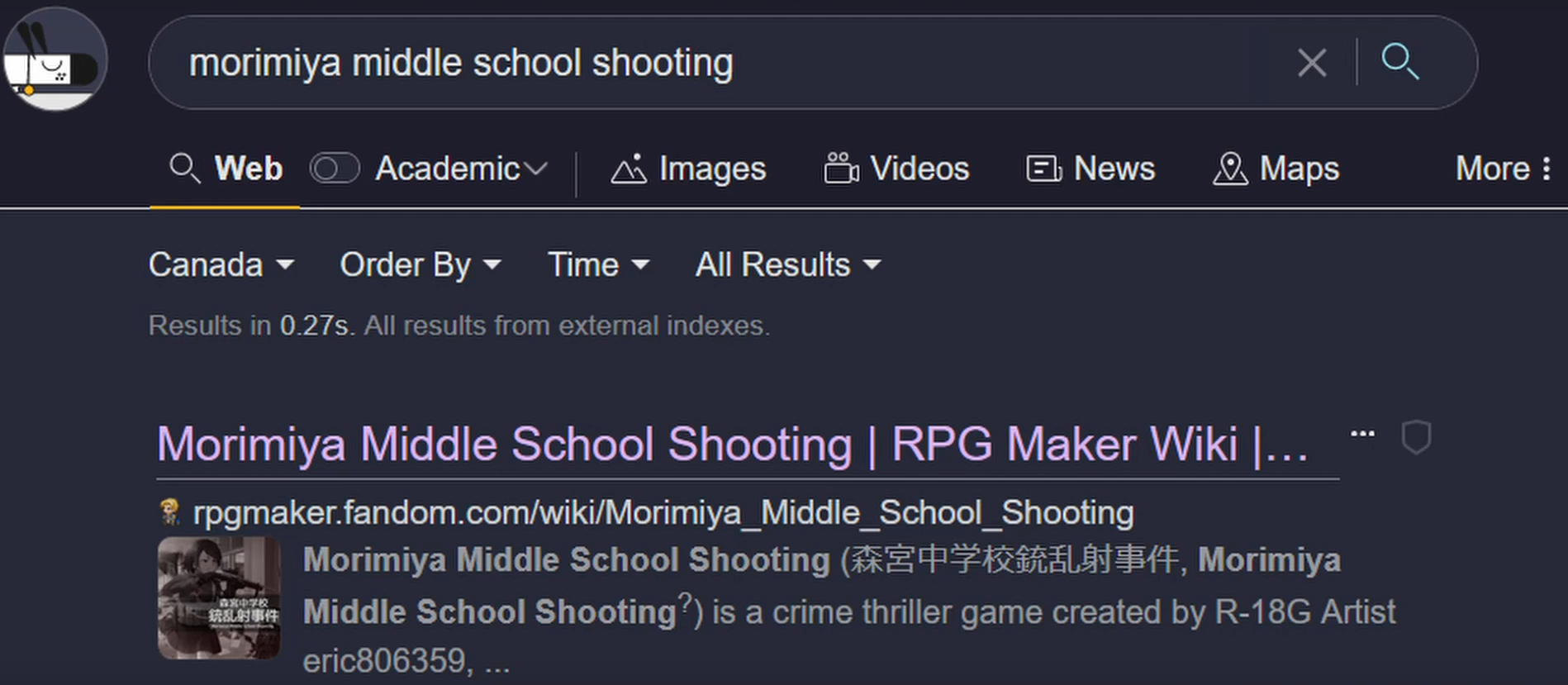
The rules for the 'Morityu Community Server' present a jarring contradiction:
- Rule 3. Don't be a weirdo. [...] You can love seeing girls suffer all you want, just don't tell everyone [...] Don't be that guy who idolizes mass shooters. It's cringe as hell [...].
- Rule 5. Do not talk about planning any mass murders [...] You may talk about previous cases of mass murder, but do not talk about the possibility of yourself or others committing crimes [...].
These rules don't prohibit celebrating violence -- they merely establish guidelines for discussing it in ways that avoid platform bans. The actual content of the server confirms this cynical reading. Members, many sporting /k/ommando iconography borrowed from 4chan's weapons board, openly share gameplay footage, compete for high scores, and exchange DOOM WADs featuring school recreations. Their discussions range from the sexualisation of violence ("do women get aroused during shootings?") to explicit political extremism, including support for Russia's invasion of Ukraine and police violence against Black Americans.
My investigation led to methrough a network of connected communities. A danbooru post (since removed) about the Christchurch mosque shootings by artist "lolipantherwww" articulated the community's ethos: focus on perpetrators rather than victims, particularly when those perpetrators understand "the memetic nature of modern media"" -- a disturbing philosophical position that frames mass violence as a form of distributed performance art.

The Fandom wiki revealed another disturbing detail: MMSS' in-game art room features portraits of actual school shooters -- not fictional representations, but real perpetrators of mass violence. This explicit glorification connects directly to yet another node in this network -- a forum dedicated to Columbine and similar atrocities. Within a thread titled "Video games about Mass Murder," users enthusiastically praise MMSS as exemplary in the genre. Many sport avatars depicting armed children, while related threads investigate what games school shooters themselves played, searching for connections or inspirations.
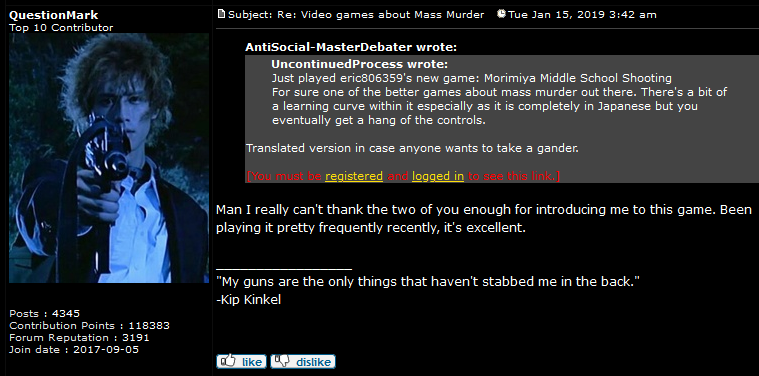
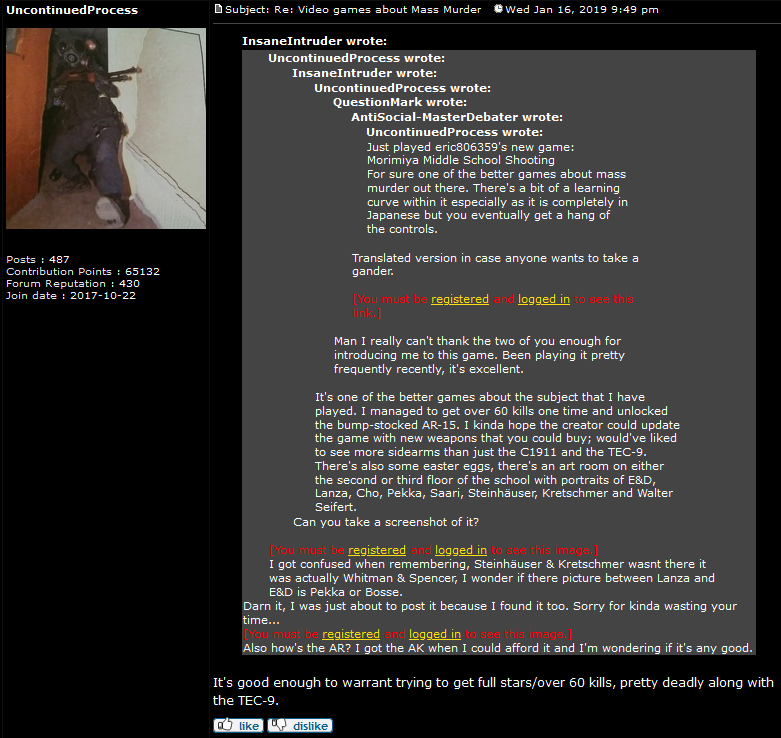

What emerges isn't just a game with a disturbed creator, but an entire ecosystem that fetishises and celebrates mass violence while maintaining just enough plausible deniability to avoid platform-level consequences.
Perpetuity: A Moritorium on Morimiya
I've now spent years with this material, digging through digital strata of human depravity, and I find myself longing for some redemptive conclusion -- some indication that erikku faced consequences, that the Discord server was purged, that the Columbine forum moderaters recognised their complicity in glorifying mass violence.
No such resolution exists. The ecosystem I've described continues unabated if not accelerated, beyond the reach of content moderation policies crafted to address more obvious violations. During this research, I experienced physical revulsion -- actual nausea as I documented these interconnections. Writing this piece triggered persistent ethical questions: Am I amplifying what should remain obscure? Is analytical distance even possible when confronting such material?
I remain convinced that games can facilitate meaningful societal introspection on difficult subjects. The medium allows for unique forms of engagement with tragedy, trauma, and moral complexity. But MMSS represents the perversion of this potential. Without critical framing or ethical contextualisation, tragedy becomes mere gameplay mechanic -- death counts become high scores, complex social phenomena become resource management puzzles, real human suffering transforms into entertainment.
What Morimiya Middle School Shooting offers isn't a mirror reflecting society's darker impulses, but a pedestal celebrating them. It doesn't invite players to interrogate violence; it encourages them to perfect it. This distinction matters fundamentally. When games addressing tragedy fail to contextualise their subject matter, they don't just miss an opportunity for meaningful commentary -- they actively contribute to the normalisation and gamification of atrocity.